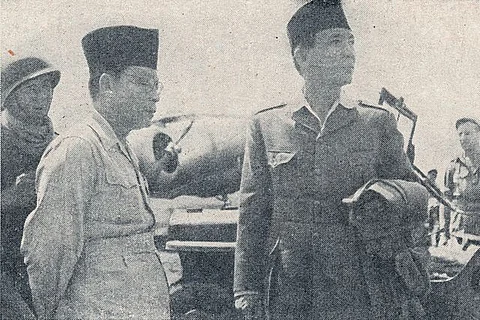

Following the end of World War II in August 1945, the global order was divided into Eastern and Western blocs. However, some nations chose to remain independent from these power structures, with Indonesia being among them.
Indonesia’s first president, Sukarno, alongside the leaders of Egypt, India, Ghana, and the former Yugoslavia, successfully established a unique foreign policy stance through the Non-Aligned Movement (NAM). This movement gained the support of approximately 100 countries, united in a shared mission to promote global peace and security.
Sukarno played a key role in shaping the Non-Aligned Movement through the "Free and Active" foreign policy doctrine. Together with his vice president, Mohammad Hatta, he likened non-aligned nations to a ship navigating between two reefs: An analogy for maintaining sovereignty amidst Cold War rivalries. His vision rejected the binary divisions of the Cold War and sought to foster peace, development, and self-determination for emerging nations. A kind of proto-multipolar world.
Under this policy, Indonesia actively supported the African National Congress in its fight against apartheid in South Africa, and it backed several independence movements across the continent. The doctrine also contributed to easing military tensions and promoting diplomacy as a means of conflict resolution.
While the Free and Active policy aimed to bolster the economic interests of developing nations, the Non-Aligned Movement ultimately struggled to achieve full economic independence. Many member states remained economically reliant on their former colonial powers, while institutions such as the International Monetary Fund (IMF) and the World Bank reinforced a global economic system that made self-sufficiency difficult for non-aligned nations.
Despite sharing the common goal of gaining independence, members of the Non-Aligned Movement had diverse political systems, national interests, and economic strategies. These differences led some nations to align more closely with the Soviet Union, while others forged stronger ties with the United States. Additionally, external pressures and coercion drew some countries into proxy wars, diverting many Non-Aligned Movement members from their original mission of promoting global peace.
These challenges raise an important question: Is Indonesia’s Free and Active foreign policy still relevant today?
The answer can be found in Indonesia’s current politics. The country has maintained its neutrality by cooperating with China on infrastructure projects, such as the Belt and Road Initiative, while simultaneously strengthening defense ties with the United States and Australia through military exercises and arms agreements. This approach enhances Indonesia’s security and economic stability while preventing overreliance on any one global power. This is in line with the "Active" aspect of its doctrine, where Indonesia has played a mediating role in ASEAN, notably in efforts to address Myanmar’s military crisis in 2021, reinforcing Indonesia’s position as a neutral and independent diplomatic player on the global stage.
Despite its successes, Indonesia has shown little interest in transforming the Non-Aligned Movement (NAM) into a formal international organization, as Sukarno once envisioned. Indonesia, once regarded as a successful example of a Non-Aligned Movement member, has faced internal challenges in maintaining its Free and Active foreign policy doctrine. A key issue lies in the lack of a clear, consistent definition of Free and Active, leading to varying interpretations and applications across different administrations. Over time, the doctrine has often been misinterpreted as a push for economic independence rather than its broader goal of ensuring independence in all aspects of foreign policy.
Its effectiveness has fluctuated from one presidency to another, leaving the doctrine in a state of uncertainty. While Indonesia has played a role in mediating conflicts through diplomacy, it lacks hard power, such as strong global institutions or military capabilities, to enforce its influence. Additionally, ASEAN’s Non-Intervention policy has further limited Indonesia’s ability to take decisive action, diminishing the broader impact of both the Free and Active doctrine and the Non-Aligned Movement itself.
Moreover, originally founded to resist the dominance of the two Cold War power blocs, NAM lost much of its strategic purpose after the Soviet Union’s collapse. Instead of a clear-cut US-USSR rivalry, the world has moved toward a multipolar order, making it increasingly difficult for NAM countries to maintain true independence. Global priorities have shifted toward non-traditional security concerns, such as cybercrime, gender equality, and environmental issues. As a result, both developing and developed nations now focus more on regional cooperation and issue-based alliances rather than NAM’s original mission. Furthermore, NAM has struggled to establish a strong decision-making framework or enforcement power, reducing it to a largely symbolic movement rather than a significant force in global diplomacy.
In conclusion, whereas the Non-Aligned Development and Indonesia's Free and Active foreign policy once played crucial parts in global strategy, their impact has melted away in a quickly changing geopolitical scene. NAM's unique mission of standing up to Cold War alliances lost much of its relevance after the Soviet Union's collapse, and Indonesia's elucidation of the Free and Dynamic doctrine has varied across organizations. Nowadays, Indonesia proceeds to maintain its impartial position, adjusting financial participation with China and security ties with Western partners. In any case, constraints such as ASEAN's Non-Intervention approach and a need of difficult control constrain its global impact. In the mean time, NAM has to a great extent gotten to be a typical substance, eclipsed by moving worldwide needs and territorial collusions.
As the world moves toward a multipolar arrangement, Indonesia faces the challenge of redefining its diplomatic role. Whether Free and Active discretion can advance to meet present day global challenges will decide Indonesia's future influence on the world stage.